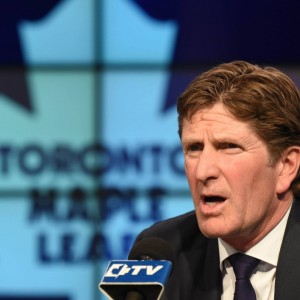When Brendan Shanahan was introduced as Maple Leafs President, he promised a culture change.
We now have a clear indication as to what he meant.
Shanahan is laying the groundwork for, what he hopes will become, a future dynasty.
For the first time (in decades, if ever), the Maple Leafs are drafting prospects with immense skill and inherent hockey-IQ. In player trades and signings, the management group has been calculated and shrewd.
For the citizens of Leafs Nation it’s been an almost euphoric off-season, highlighted by a number of significant personnel changes.
The the addition of Lou Lamoriello as club GM. The philosophical change in the way the Maple Leafs are drafting. The historic signing of Mike Babcock as head coach, and the trading of Phil Kessel; all examples of how this team has taken an organizational shift forward.
Roster Change

The worst thing a GM in professional sports can do is fall in love with his own players. When it happens, that manager can lose sight of the true market value of that player, and potentially overpay the athlete.
This current Maple Leafs management group has been able to remain fairly emotionless in regards to the players they inherited on this roster.
Take the Phil Kessel trade as an example; regardless of your personal opinion as to if the Leafs won the trade, or (as some would suggest) the Leafs gave Kessel away, it was a move that was necessary to shift the mentality and culture of this team forward.
Kessel, despite being one of the best pure goal-scorers in the NHL, was never going to evolve into the player that Maple Leafs brass or fans wanted him to become. His effort, fitness, and attitude were constantly questioned. His attitude and approach with the media turned him from a hero to a heel. Irrespective of your personal opinion on the Kessel trade, the management group deserves credit for actually pulling the trigger on the deal.
But it’s more than just that trade. Signing free-agents like PA Parrenteau, Mark Arcobello, and Shawn Matthias. Bringing back a character guy like Daniel Winnik. The decision not to overpay or overcommit to Nazem Kadri, instead offering him a one-year bridge contract. These roster decisions are all indications of how the organizational philosophy has changed.
The arbitration case of Johnathan Bernier is another example of how Maple Leafs management is remaining emotionless when it comes to contract negotiations. Bernier’s camp was reportedly asking for north of $5 million, while the team was reportedly offering somewhere between $2 and $3 million. While the two sides had started the arbitration process, Bernier and the Maple Leafs settled on a two-year, $8.3 million deal before the arbitrator could issue a ruling.
The point here being, management didn’t fold like a cheap suit. Unlike years past, the Leafs brain-trust stood their ground, played hard ball, and negotiated a fair contract (in money and term) for both the player and the team.
[optinform]
Management Mentoring Management
Some folks may have scratched their head after learning about the signing of the 72-year-old Lou Lamoriello. But its a signing that makes a lot of sense on the short-term and on the long-term future of the Maple Leafs. The signing, as much of a surprise as it was, is also an indication of the power and influence that Brendan Shanahan has.
In the short-term, the Maple Leafs have a respected and credible GM at the helm. Lamoriello will manage the cap, negotiate contracts, and be the main point of contact for trade calls. Lamoriello is experienced, revered, and influential. His opinion matters and resonates with players, managers, and even the NHL head office. Lou Lamoriello instantly brings a level of credibility to the Maple Leafs front office.
Over the long-term, Lou Lamoriello will serve as a mentor for the less experienced Kyle Dubas (and to a certain extent, Mark Hunter). Lamoriello will groom Dubas (and Hunter) to eventually become his successor, while also teaching them the intricacies of being an NHL general manager. Lamoriello is a NHL legend and a hall-of-famer. There aren’t many better mentors for an up-and-coming NHL GM than ‘Uncle Lou’.
While Shanahan’s influence and power of persuasion are certainly an asset for this Maple Leafs franchise, the old-school mentality that Lamoriello brings to the table should help balance out an already crowded front-office bent on an unorthodox and innovative approach to management. With a mix of old and new, the Maple Leafs have one of the most dynamic management groups in the NHL.
The Value of Babcock

The fact that the Maple Leafs were actually able to lure Mike Babcock to Toronto is somewhat mind-boggling.
Reports from the ‘hockey insiders’ were all over the place. The Leafs were frontrunners. Then they were totally out of the picture. Finally, at the last moment, the Maple Leafs came in with an offer Babcock couldn’t resist.
With Babcock at the helm, the players wearing the Maple Leafs crest will now face a level of accountability which has seldom been enforced since the likes of Pat Quinn & Pat Burns controlled the Leafs bench.
That’s not too suggest that the Maple Leafs haven’t had good hockey coaches since Burns and Quinn, but the level of authority and structure that Babcock will demand of his players is something this team sorely needs.
What Babcock brings to behind the bench, is something that this team has lacked for years; a totalitarian approach to the game.
If a player isn’t willing or capable of playing under Babcock, that player will be deemed expendable or moveable.
No one player is bigger than the team, and that’s a refreshing change to the future of the Maple Leafs, a team that in recent history has allowed a divide to develop between the star players and the role players.
‘Draft, Shmaft’ No More!
The Maple Leafs draft record, simply put, is abysmal. It’s pretty painful to look back at some of the draft day duds the Maple Leafs selected over the years. It’s equally depressing to look at the list of studs that Toronto traded away. To put things into perspective, here’s an idea of how poorly the Maple Leafs have drafted between the 1999 draft and the 2012 draft.
Over those 14 NHL Entry Drafts, the Maple Leafs selected a total of 109 players, with 11 having been picked in the first round.
From the 109 Maple Leafs picks, just 18 (or 16.5%) have played in a minimum 150 NHL career games.
The team has seemingly had better success drafting NHL capable players in the first round, as 8 of their 11 picks have played in at least 150 NHL career games. However, just half of those 8 players (Alex Steen, Luke Schenn, Nazem Kadri, Morgan Rielly) accomplished the 150 games milestone with the Toronto Maple Leafs.
So between 1999 and 2012, just 36% of Toronto’s first round draft picks played at least 150 NHL career games in a Maple Leafs uniform.
But for the first time in decades, the Maple Leafs are drafting for skill. Typically, if a team is attempting to acquire a skill player via the open market or trade, the team has to pay a high premium because skill is so valuable. But the draft is the one time when you don’t have to over pay to acquire skill.
The approach of picking highly skilled players with a high potential is something that can be attributed to the Shanahan regime. It began at the 2014 NHL Entry Draft, when the Maple Leafs held the 8th overall selection.
It was widely speculated that the team was eyeing Nick Ritchie, a power forward who plays a rough and tough game, but also possess a certain skill set. Instead Toronto opted to pick an undersized, but unbelievably talented forward in William Nylander. At the time, pundits opined that Nylander could be the most skilled player in the draft. The Leafs got a very dynamic player, and a potential franchise star.
Fast-forward to the 2015 NHL Draft, and the Maple Leafs once again opted for skill over brute force. With the 4th overall pick the Maple Leafs picked Mitch Marner, a small but skilled and speedy forward. This past season with the London Knights of the OHL, Marner finished second in the league scoring race, posting 44 goals and 126 points in 63 games. Marner is likely still a few years away from making the Maple Leafs roster, but for the second straight draft, Shanahan and his advisors picked for skill.
Most encouraging for Maple Leafs fans, is the Shanahan approach to the late rounds of the draft. Whereas in years past Toronto management would have been quick to trade or write off late round picks, Shanahan’s regime is looking for late round steals.
The selection of both Dmytro Timashov (125th overall, 5th round) and Nikita Korostelev (185th overall, 7th round) speak to just that. There’s no guarantee that either prospect will pan out, but both players have had an impact since joining the CHL.
Nikita Korostelev spent the past two seasons with the Sarnia Sting of the OHL. In 2014-2015 he produced just under a point per game, finishing the season with 24 goals and 53 points in 55 games. He’s fast, he’s got great hands and a lightning quick release, and has the ability to make something out of nothing. Check out this highlight goal that Korostelev scored during his OHL rookie season from 2013.
In the case of Dymtro Timashov, the Maple Leafs hope to have a playmaker with an innate ability to think two-steps ahead of the play. In his first season with the Quebec Ramparts of the QMJHL, Timashov tallied 71 assists and 90 points in 66 games played. He is a student of the game, and thrives on being a set up guy.
In Shanny We Trust
The Maple Leafs are likely to get worse before they get better. But for the members of Leafs Nation, there is reason to believe that (eventually) the franchise will return to glory.
It’s going to be a bumpy road, but given the approach and strategy that Brendan Shanahan and his management team have implemented and executed so far, the not so distant future could be very bright for the Toronto Maple Leafs.